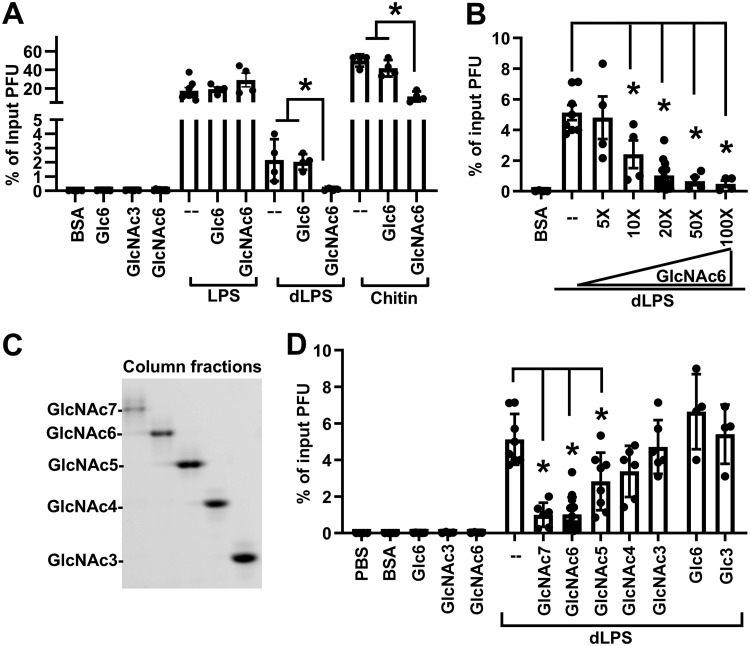FIG 4.
Excess GlcNAc6 inhibits polysaccharide-mediated stabilization of poliovirus. (A) Excess GlcNAc6 inhibits detoxified LPS (dLPS) and chitin-mediated stabilization of poliovirus. Poliovirus (106 PFU) was incubated with compounds at 45°C for 5 h. Remaining titers after incubation were quantified by plaque assay and normalized to the result for the untreated control. Concentrations of compounds: 0.01 mg/ml for LPS; 0.05 mg/ml for dLPS; 0.5 mg/ml for chitin; 1 mg/ml for BSA, GlcNAc3, GlcNAc6 (20-fold of dLPS), Glc3, and Glc6. Results represent mean ± SEM (n = 4 to 8). *, P < 0.05 by one-way ANOVA. (B) The inhibition effect of GlcNAc6 is concentration dependent. Experiments were performed as for panel A, but different concentrations of GlcNAc6 were used. Concentrations of compounds: 0.05 mg/ml for dLPS, 1 mg/ml for BSA, 0.25 mg/ml (5×) to 5 mg/ml (100×) for GlcNAc6. Results represent mean ± SEM (n = 4 to 14). *, P < 0.05 by one-way ANOVA. (C) FACE analysis of purified glycans containing 3 to 7 GlcNAc units. Chitin was hydrolyzed by acid to generate water-soluble oligosaccharides. GlcNAc oligomers were fractionated with a Bio-Gel P-4 size exclusion column and analyzed by FACE. (D) The chain lengths of GlcNAc oligomers affect their inhibition efficiency. Experiments were performed as for panel A. Concentrations of compounds: 0.05 mg/ml for dLPS; 1 mg/ml for BSA, GlcNAc3, GlcNAc4, GlcNAc5, GlcNAc6, GlcNAc7, Glc3, and Glc6. Results represent mean ± SEM (n = 4 to 14). *, P < 0.05 by one-way ANOVA.

